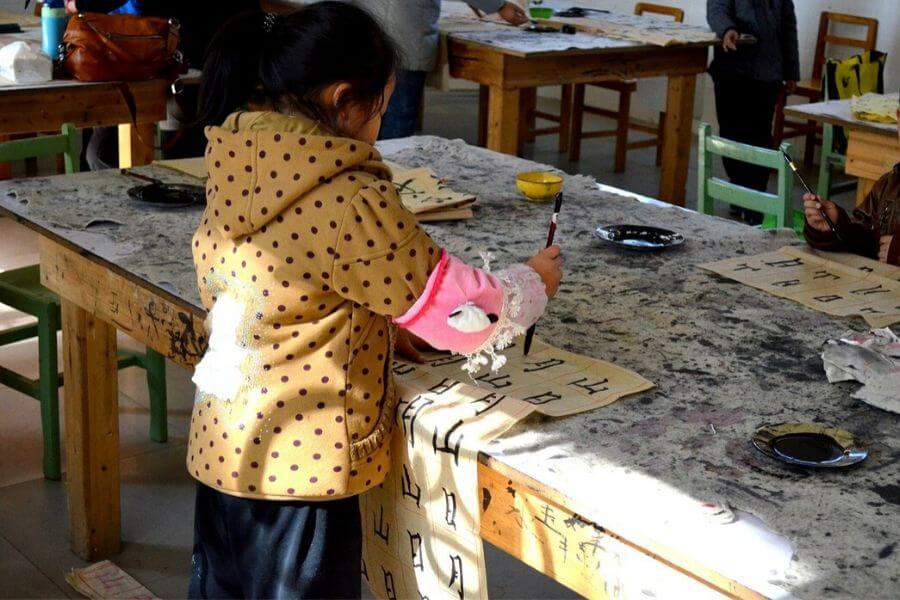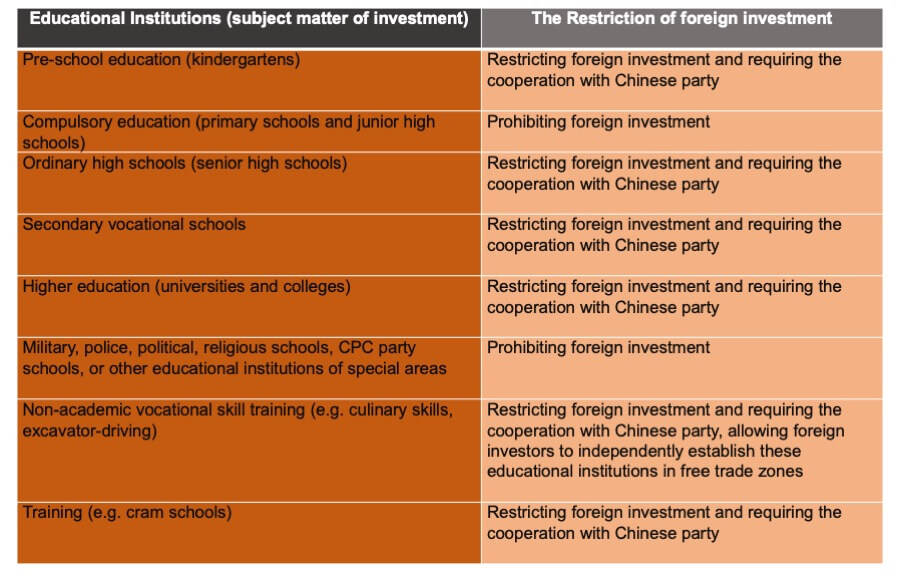
The PRC Foreign Investment Law, which came into force on 1st Jan. 2020, established the foreign investment regulatory framework of “pre-establishment national treatment + negative list”, further loosening the restriction of foreign investment in various areas. However, in respect of foreign investment in education, Chinese government still maintains a cautious approach towards the initial entrance stage and sets different investment restrictions for different educational institutions (the subject matter of investment).
I. The Classification of Educational Institutions
In China, educational institutions can be classified according to the following criteria. [1]
First, according to the stages of education, educational institutions can be divided into pre-school, primary school, junior high school, senior high school, and higher education, as well as secondary vocational schools and colleges. Primary school and junior high school education are China’s nine-year compulsory education stage.
Second, according to whether academic degree certificates are awarded, education can also be categorized into academic education and non-academic education. Academic education refers to the form of education in which schools admit students according to the enrollment plan issued by the Ministry of Education, teach in accordance with a teaching plan approved by the education authority, and issue graduation and degree certificates uniformly printed by the state. In contrast, non-academic education refers to various training and refresher courses, upon completion, the training institutions will issue the corresponding certificates.
Third, education can also be divided into online and offline education based on the form of teaching. Online education generally refers to distance learning via the Internet, which is similar to online training; while offline generally adopts the traditional face-to-face teaching mode.
Four, distinguished by whether to use the State funding to run the school, there are private schools and state schools. Private schools refer to schools or other educational institutions that are run by non-state organizations or individuals to meet the demand of society, utilizing non-state financial funds. State schools are run by the government utilizing State funding.
Fifth, private schools can be further classified as for-profit and non-profit private schools. For-profit private schools can only provide pre-school, high school, or higher education, but they shall not be used for compulsory education; while non-profit private schools are not subject to such restrictions.
II. The Restrictions of Foreign Investment in Education
1. Prohibiting Foreign Investment in Compulsory Educational Institutions
Chinese regulatory authorities have always prohibited foreign investment in compulsory educational institutions. Article 11 of the Special Administrative Measures (Negative List) for the Access of Foreign Investment (2019) (外商投资准入特别管理措施(负面清单)) retains this rule. Some Chinese enterprises that intend to list outside China, control some educational institutions engaged in compulsory education. In order to include these educational institutions in the listed assets, they will try to circumvent this prohibition through Variable Interest Entity (“VIE”) structure or other methods.(For issues concerning the VIE structures, please read “Foreign Investment Law Series -05: the VIE Structure Remains in Grey Area”.)
However, the interpretation of the prohibition on foreign investment in compulsory education may become increasingly strict. This is because although the Foreign Investment Law avoids to clearly provide the legitimacy of the VIE Structure, the Regulations on the Implementation of the Non-state Education Promotion Law of the People’s Republic of China(中华人民共和国民办教育促进法实施条例) (draft for review)(“the Regulations Draft”), which is under review and is related to the prohibition of foreign investment in education, intends to clearly identify the VIE Structure as an investment method. Article 5 of the Regulations Draft stipulates that “foreign-invested enterprises established in China and the social organizations whose actual controllers are foreigners shall not host, participate in the host or actually control the private schools which are used for compulsory education”. And Article 12 thereof provides that “the group-run schools shall not control non-profit private schools through mergers and acquisitions, franchising chains, agreements or any other methods”. The expressions “actual control” and “controlled by agreements” in the above two provisions can both cover the VIE structure. Therefore, if the Regulations Draft formally come into force, it is no longer feasible to try to circumvent the prohibition of foreign investment through the VIE structure or other means.
2. Foreign Investment in Non-compulsory Education Is Confined to Chinese-foreign Cooperative Education
As for pre-school, senior high school and higher education, the foreign investment can only be in the form of Chinese-foreign cooperation education, meaning that the school must be led by the Chinese side (the principal or principal in charge of administration shall have Chinese nationality, and the Chinese members of the council, the board of directors or the joint administration committee shall be no less than 50%).
At the same time, foreign investors should also meet the following specific requirements. (1) The proportion of foreign investment in Chinese-foreign cooperative private schools shall be less than 50%. (2) Foreign investors applying for the establishment of Chinese-foreign cooperative education should have appropriate qualifications and high education quality, namely the foreign educational institutions with high education quality. [2]In practice, there are few foreign investors who can meet the criteria, so Chinese-foreign cooperative educational institutions are rarely approved.
3. The Summary of Prohibitions
Based on the restrictions above, and taking different subject matter of investment into consideration, we make a brief summary as follows. [3]

[1] 李俊杰:《聚焦教育行业法律法规与监管政策》2019年4月25日发布< https://mp.weixin.qq.com/s/MtZASv5OmR9YmVseKtcrHg >
[2] 《中华人民共和国中外合作办学条例》
[3] 林日升:《一文读懂教育行业外商投资限制|PE实务》2018年7月2日发布< https://mp.weixin.qq.com/s/vwfNTlIDV__DSvw2bD1Tww >
Cover Photo on pixabay (https://pixabay.com/zh/photos/wuhan-university-dorm-room-spring-2193990/)
Contributors: Xiaodong Dai 戴晓东









